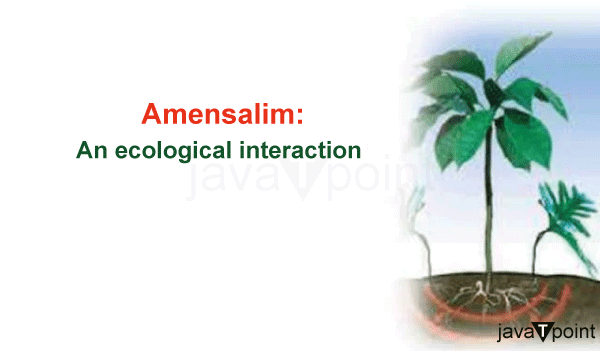AmensalismThere are several relationships between various Earth species. However, they are not all positive. One example of a negative association between two species is amensalism. Let us first define amensalism. When two species interact ecologically, amensalism occurs when one organism is exterminated or hampered while the other is left unharmed. Furthermore, the term amensalism is widely used to describe unequal competitive engagement. 
Amensalism is the relationship of organisms of different species in which one is suppressed or destroyed while the other remains undamaged. There are two main types: antibiosis, in which one organism remains unharmed while the other is hurt or killed by a chemical secretion, and competition, in which one organism eliminates a smaller or weaker one from living space or denies it food. The destructive impact of the bread mould Penicillium on specific bacteria is a typical example of antibiosis; the secretion, known as penicillin, has become a powerful drug in battling bacterial illnesses. Some higher plants release chemicals that impede the growth of surrounding competitive plants or kill them outright. For instance, the black walnut (Juglans nigra) secretes juglone, an organic compound that kills numerous herbaceous plants inside its root zone. Amensalism ExamplesSome prominent amensalism examples are provided below-
Amensalism TypesAs previously stated, amensalism is defined as a reaction in which one organism is injured while the other remains untouched. Antibiosis and competition are the two categories into which this relationship between the two species may currently be subdivided. Definition of AntibiosisThe term 'antibiosis' is derived from the French word 'antibiosis'. The phrase was coined by Vuillemin in 1889-1890 to depict a conflict between various animals within an ecosystem. Additionally, at least one of the two species is harmed by the biological interaction between the two. A penicillium is a well-known example of an antibiosis. The bread mould penicillium produces penicillin, which is highly poisonous to bacteria. It has developed into a powerful antibiotic for bacterial infections as a result. Another typical example of this phenomenon is the substance judone, which is secreted by black walnut trees. This hazardous ingredient can kill other plants that live in its root zone. Antibiosis can also be seen in the connection between antibiotics and bacteria. Furthermore, research into antibiosis and its role in antibiotics has resulted in new discoveries in microbiology. Researchers have gained a better knowledge of antibiotics thanks to molecular mechanisms such as cell wall production and recycling. Scientists now have a better understanding of how antibiotics influence beta-lactam formation through antibiosis. Furthermore, they can now establish the relationship and interactions of specific medications when bacteria are exposed to the molecule. Definition of CompetitionIn biology, competition refers to an amensalism relationship between two species vying for survival. This competitiveness originates from the fact that the earth's resources are limited, and there is insufficient for everyone. Depending on the species vying for a particular resource, competition has different effects. Four categories might also be used to split this competition. Between Inferior and Superior: When inferior and superior species, like a goat and a beetle, compete, one of them will inevitably become extinct. Shrubs provide food for beetles and goats. However, goats were unhurt when digesting it, but a beetle could be wounded. Beetles not only lose a significant amount of food, but they also risk being devoured by a goat. On the other hand, a contest between two closely related species is a more fair affair. For instance, one of the animals will almost certainly die or be hurt if a lion and a tiger battle over a deer. Between Two Similar Species: The rivalry in this scenario is between two creatures of the same species. For example, when two tigers compete for a single pray. They may have killed it jointly, but now they're fighting for the biggest piece of the pie. Between Two Organisms from Different Species: When two species of different organisms contend for the same resource: When two organisms of different species contend for the same resource, this circumstance occurs. The prior example of a lion and a tiger battling over a single deer is a good fit here. Amensalism is required to keep the ecosystem in balance.
Next TopicAmmonification
|
 For Videos Join Our Youtube Channel: Join Now
For Videos Join Our Youtube Channel: Join Now
Feedback
- Send your Feedback to [email protected]
Help Others, Please Share









